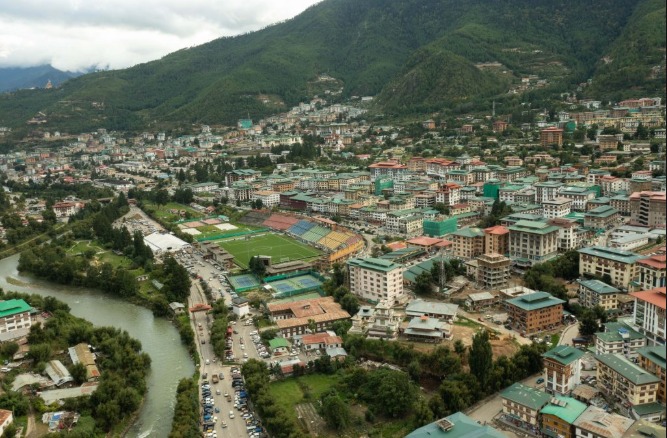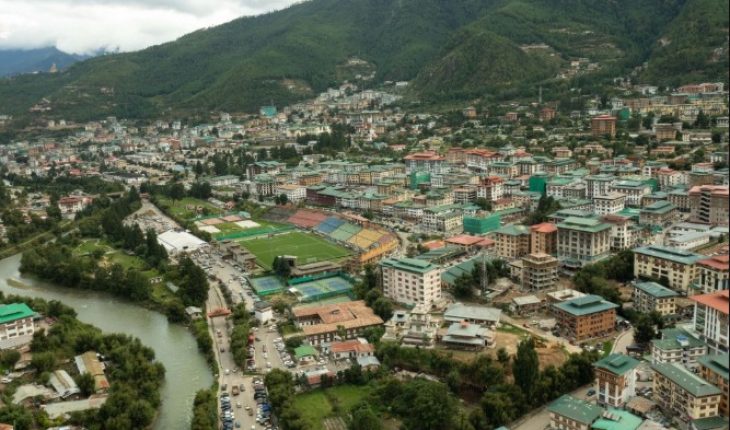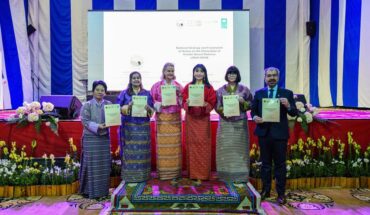
NGAWANG JAMPHEL | Thimphu
The Ministry of Infrastructure and Transport (MoIT), in partnership with Thimphu Thromde, has introduced the Thimphu Structure Plan (TSP) 2023.
The TSP charts out a comprehensive vision to manage population growth, respond to the pressures of rapid urbanization, and strengthen the city’s public transport system.
The announcement was made by the MoIT Minister Chandra Bdr Guring during the 19th Meet the Press session, highlighting the need for a renewed plan to guide Bhutan’s capital into the future.
Thimphu faces unique urban challenges due to its topography. Surrounded by mountains, the city has expanded linearly along the valley, limiting opportunities for outward growth.
The TSP 2023 has been designed to address these constraints while ensuring that the capital grows in a compact, sustainable, and inclusive manner.
According to the minister, the plan marks a major step forward in preparing Thimphu to become a resilient and livable city for generations to come.
With Thimphu’s population projected to continue rising, the structural plan emphasizes managing growth within the existing urban footprint rather than encouraging outward sprawl.
Compact development, supported by densification and regeneration, is a key focus of the plan. Area types and land-use designations have been refined to ensure a more strategic allocation of housing, workplaces, community facilities, and public open spaces.
The designations take into account population catchments and community needs, aiming to create balanced neighborhoods where residents can access essential services more easily.
Equally important, the plan restricts development in geo-hazard-prone and environmentally sensitive areas. By doing so, the government seeks to prioritize both safety and sustainability, ensuring that the city grows without compromising its natural environment or exposing residents to avoidable risks.
In addition, rapid urbanization has placed significant pressure on Thimphu’s urban core, especially in terms of housing, employment, and public services.
To address this, the TSP introduces a centres hierarchy, a planning approach designed to distribute jobs, homes, and facilities more evenly across the city. This decentralization aims to reduce pressure on the city center and promote balanced growth.
Each neighborhood, defined by its area type, will be enhanced through tailored design guidelines. These guidelines cover built form, public realm, open spaces, and heritage conservation, with the goal of improving livability and character.
According to the ministry, this approach will help strengthen community identity and resilience while also creating more inclusive urban spaces.
The minister highlighted that the TSP is not just about accommodating demand but about shaping the kind of city Bhutan wants Thimphu to be.
“Balanced neighborhood development is essential for fostering inclusivity, resilience, and a strong sense of community,” he said.
Public transport is a central pillar of the new structural plan, with measures introduced to ensure mobility keeps pace with urban growth.
The TSP envisions a shift toward more people-friendly and efficient systems that reduce reliance on private vehicles. Pedestrian routes will be expanded to improve walkability across the city, making it easier and safer for residents to move around on foot.
Norzin Lam, one of the city’s busiest corridors, is set for significant transformation, with its laneways redesigned into a vibrant, pedestrian-friendly space.
Dedicated public transport routes supported by modern infrastructure will be introduced, alongside the establishment of a regional transit hub and a distribution and logistics hub. These hubs are expected to streamline connectivity both within the city and with surrounding regions.
The plan also designates Doebum Lam as Thimphu’s primary north–south transport corridor, strengthening the city’s main mobility spine.
Junction improvements will help reduce congestion, while parking management strategies will relocate surface parking into central mobility hubs, easing traffic in the city core.
Beyond technical provisions, the TSP reflects a broader vision of what Thimphu should become. The government stressed that sustainable growth must go hand in hand with livability, community well-being, and respect for the environment.
By integrating open spaces, heritage conservation, and neighborhood character into the plan, TSP 2023 seeks to ensure that the capital retains its unique identity even as it modernizes.
The minister described the plan as a “framework for transformation,” pointing out that the challenges of population growth and urbanization cannot be solved by ad hoc measures.
Instead, a long-term strategy that addresses land use, housing, transport, and public services in an integrated way is essential for the city’s future.
The TSP 2023 sets out a roadmap for Thimphu’s growth over the coming decades.
By focusing on compact development, balanced neighborhood planning, and improved public transport, the plan seeks to avoid the pitfalls of uncontrolled sprawl and traffic congestion that often plague rapidly growing cities.
However, implementation will require sustained effort, resources, and collaboration between multiple stakeholders. Thimphu Thromde will play a central role in bringing the plan to life, while coordination with national agencies, private developers, and local communities will also be crucial.
For now, the TSP 2023 offers a hopeful vision — one in which Bhutan’s capital becomes a model of sustainable urban growth.
“Through these measures, Thimphu can grow into a resilient, inclusive, and liveable city for generations to come,” the minister said at the press briefing.





